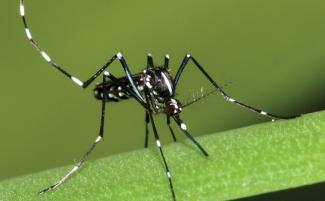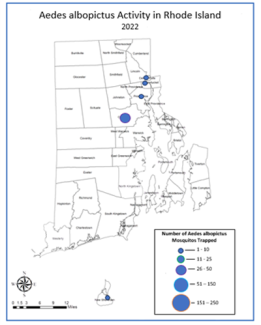Asian Tiger Mosquito (Aedes albopictus)
The Asian tiger mosquito (Aedes albopictus) has become prevalent in Rhode Island urban environments. It is notable as a daytime biter encountered in shaded backyards. It has a striking black and white pattern evident to the naked eye and is about 1/4-inch long. It has a white stripe running down the center of its head and back with white bands on the legs.
The Asian tiger mosquito usually does not fly more than about 1/2 mile from its breeding site. These mosquitoes lay their eggs in water-filled natural and artificial containers like cavities in trees and old tires; they do not lay their eggs in ditches or marshes. The public is urged to remove standing water from containers such as buckets, pots, wheelbarrows, boats, and pools. Clogged rain gutters and puddles formed on tarps also can support the larvae of this species.
The Asian Tiger Mosquito is known to transmit several diseases, including WNV.

Aedes albopictus in Rhode Island
The Asian tiger mosquito was introduced into the continental United States in the early 1980s, when it was found in tire casings imported to Texas for recapping. Scrap tire transportation was likely a method for this mosquito to travel across the United States as well, as the early pattern of spread aligns with the map of the interstate highway system. Early establishments of this species were first identified throughout the Southern region of the U.S., before they began invading the Northeast and the West Coast.
The Asian tiger mosquito was first trapped in Rhode Island in 2010 and has become prevalent in Rhode Island urban environments. Its ability to survive and reproduce in the state, and elsewhere, has been increasing due to warming winter temperatures. This increase is apparent when looking at the difference in the number of mosquitos trapped across Rhode Island in 2022 compared to 2023. In 2022, 54 Asian tiger mosquitos were trapped in the state. In 2023, this number jumped to 734 Asian tiger mosquitos trapped. The maps below visualize a comparison of the number of Aedes albopictus mosquitos trapped in Rhode Island in 2022 versus 2023.


Personal protection is the first line of defense against mosquitoes that may carry WNV, EEE, or other diseases – and the most effective way to avoid infection.
What You Should Do
Protect yourself
- Put screens on windows and doors. Fix screens that have holes.
- Aedes albopictus is most often active during midday. If you must be outside, wear long-sleeved shirts and long pants and use bug spray.
- Use bug spray with at least 20% DEET (N, N-diethyl-meta-toluamide). Make sure that bug spray does not have more than 30% DEET. Do not use bug spray with DEET on infants.
- Put mosquito netting over playpens and baby carriages.
Get rid of mosquito breeding grounds
- Get rid of anything around your house and yard that collects water. The Asian tiger mosquito needs only a small amount of water to lay eggs. Bowls, cups, fountains, tires, barrels, vases and any other container storing water make a great “nursery.” One cup of water can produce thousands of mosquitoes!
- Clean your gutters so that they can drain properly.
- Remove any water from unused swimming pools, boats, or water features and cover them.
- Change the water in birdbaths at least two times a week.
- Help your neighbors, friends and family do the same things.
Adult female mosquitoes lay their eggs on the inner walls of containers with water, above the waterline. The eggs stick to the container like glue and can survive drying out for up to 8 months. Larvae hatch from the eggs when water covers the eggs. The larvae swim with a wriggling motion and are sometimes called “wrigglers.” About 10 days after hatching, the larvae are about 1/4-inch long and completely grown. They then change into comma-shaped pupae. The pupa stage completes their development into adult mosquitoes. When fully developed, an adult mosquito will emerge from each pupa at the water surface. Adult mosquitoes emerge from pupae in as little as 10 to 14 days after the eggs hatch during the summer.
Asian tiger mosquitoes spend the winter in the egg stage, hatching into larvae when the eggs are covered with water in the spring and summer. The larvae feed on small bits of debris and bacteria in the water.
Male mosquitoes feed on plant juices and do not bite. Female mosquitoes seek blood to help their eggs develop. Unlike many other mosquitoes, the Asian tiger feeds during daylight hours, not at night. As with other mosquitoes, though, Asian tiger mosquitoes are attracted to dark clothing, perspiration, carbon dioxide and certain other odors. The mosquito will bite squirrels, dogs, deer and other animals as well as people. About four or five days after feeding on blood, the female mosquito lays her eggs just above the surface of the water in a hard-sided container like a tree hole, old bucket or tire. When rain covers the eggs with water, the larvae hatch.
The tiger mosquito is an important disease carrier in Asia. In the United States, it has been found to be infected with LaCrosse encephalitis viruses and West Nile virus, which can cause encephalitis (inflammation of the brain).
The bite of the Asian tiger mosquito is not particularly irritating to most people, but they are persistent biters. Because they breed in nearly any sort of water-filled container, they often become very common and bothersome, even in neighborhoods where there are normally few mosquitoes. In some southern cities, the Asian tiger mosquito has become the most important nuisance mosquito.
Additional Resources
- RIDEM Mosquito Control
- RIDOH Mosquito Disease
- RIDOH WNV / Arbovirus Surveillance Reports
- Climate Change and Mosquitoes (English) (Spanish)


